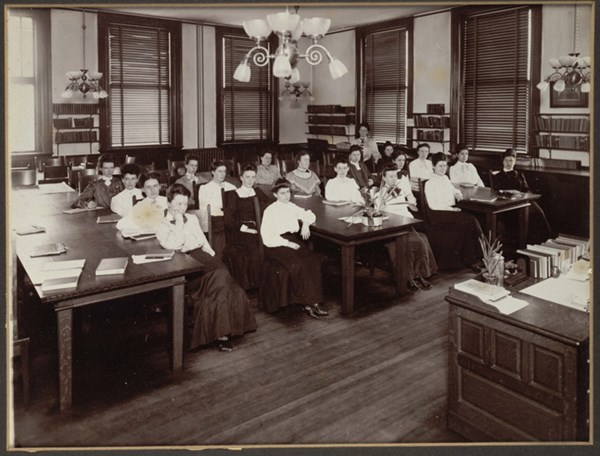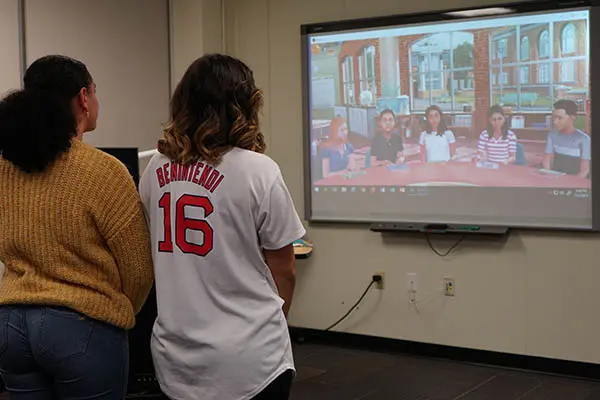
A classroom of Lowell Normal School students.
In 1894, the Massachusetts Legislature approved the creation of a two-year teacher training school in Lowell, the last of 10 such schools chartered by the state. The Lowell Normal School began classes in 1897 under Principal Frank Coburn, before the building was even finished. The students – nearly all women – studied educational methods, English, math, science, drawing and physical education. They also observed and taught at the nearby Bartlett Training School, a Lowell public school, and then graduated with certificates in elementary education.
The next principal, Cyrus Durgin, introduced a new specialty, music education, which required a third year of study. As state teaching standards grew more rigorous, the school adapted, offering a three-year teaching certificate in the 1920s. In 1932, under President Clarence Weed, it became a four-year institution with a new name: Lowell State Teachers College.

Students pose for a photo at State Teachers College in 1946.
The Great Depression cut into enrollments, though, and when James Dugan succeeded Weed as president in 1936, the first order of business was opposing a state plan to close several of the state teachers colleges. The colleges mounted a successful campaign to stay open, arguing that they were necessary to provide opportunities to young people in the state’s smaller cities and to help the cities’ economies recover.
Less than a decade later, the colleges all grew exponentially as young men returning from service in World War II took advantage of educational benefits under the GI Bill®. Starting in 1950, college President Daniel O’Leary oversaw Lowell State’s transformation into a fully accredited college that awarded degrees for high school teachers in specific subjects, including history and science.
As Lowell State Teachers College became Massachusetts State College at Lowell, the school also offered its first liberal arts degree and won approval to offer master’s degrees in education and music education. The Department of Education was now one of several on a campus that had expanded to include six new buildings, all named after former principals and presidents of the school. Then, in 1975, Lowell State and Lowell Technological Institute combined to become the University of Lowell.
 Image by K. Webster
Image by K. Webster
Undergraduate education majors Mykala Guzman and Angela Messina practice teaching a lesson in a virtual classroom in 2018.
In the early 1980s, the College of Education phased out its undergraduate teaching major and became certified to offer a doctorate in education (Ed.D.). After the last undergraduate class left, in 1985, the college moved to West Campus in North Chelmsford. In 1990, university Chancellor William Hogan changed its name to the Graduate School of Education to reflect its mission.
In 2003, more than a decade after ULowell joined the University of Massachusetts system, the Graduate School of Education returned to South Campus, taking up residence in O’Leary Library. As part of the university’s 125th anniversary celebration, the college is returning to its original home in Coburn Hall, which is being expanded and renovated from top to bottom. New facilities include a model classroom with state-of-the-art technology.
Today, the renamed School of Education offers a Ph.D., a mostly online Ed.D., hybrid master’s programs leading to licensure in several specialties, and a newly revived undergraduate teaching degree with certification in elementary education and moderate disabilities. The school is becoming a leader in state efforts to diversify the teaching workforce and prepare educators for the 21st century.
